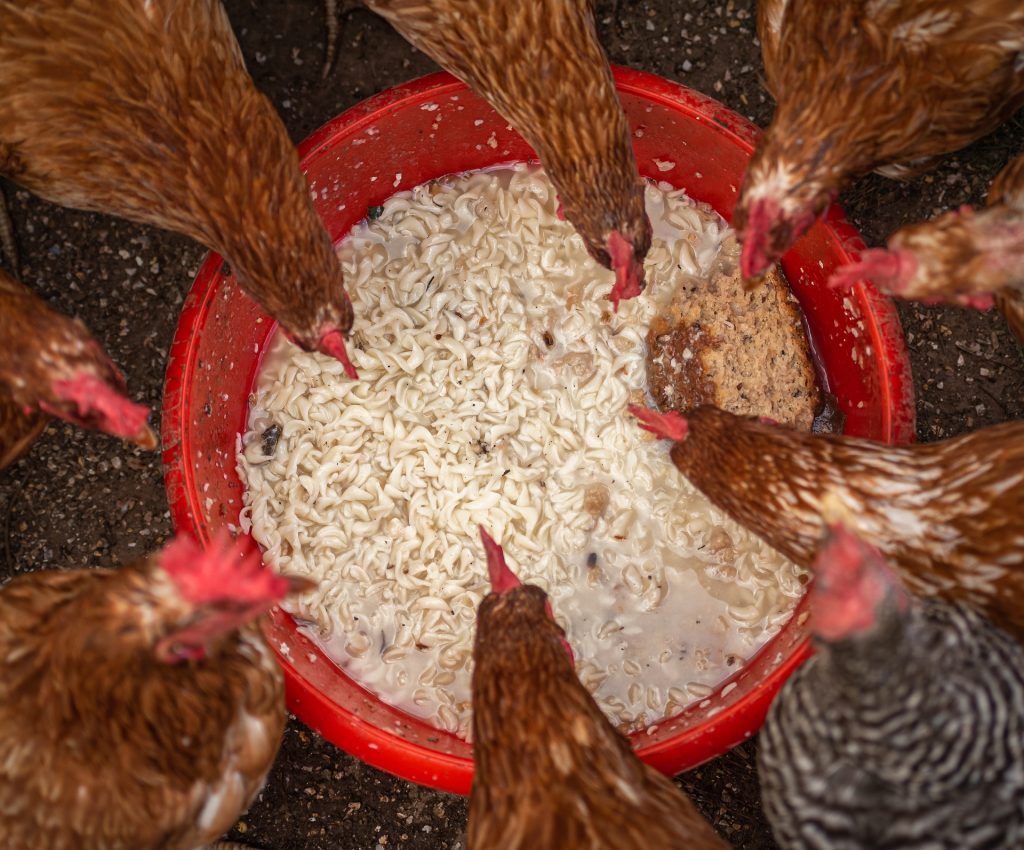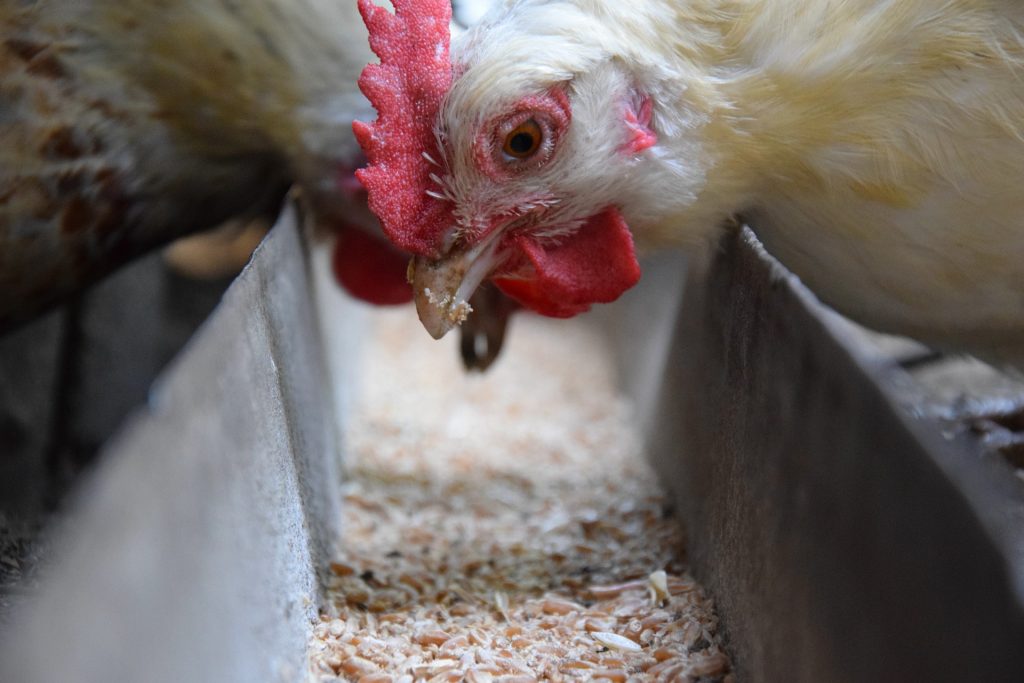If you’re a backyard chicken owner or are considering adding some feathered friends to your family, you’ve probably heard the term “chicken grit” thrown around. But what exactly is it and why is it so important for your chickens’ health?
In simple terms, chicken grit is finely crushed stone, typically made from granite or quartz, that is fed to chickens to aid in the digestion of food. Chickens don’t have teeth like humans do, so they rely on grit to grind up their food in their gizzards.
I remember as a child back in the 60’s my Grandmother would let the chickens roam around the area near her garage, where she had the roost. I asked her once if she was worried about them running off, she just said “thall all know where there live, but they need to get to the sand on the road. They eat and it helps them get big.”
Without grit, their digestive system wouldn’t be able to properly process the food they eat, leading to potential health issues such as impacted crop and other digestive problems. That’s why providing your flock with access to grit is crucial for their overall well-being.
What is Chicken Grit?
If you’re a chicken owner, you’ve likely heard the term “chicken grit” before. But what exactly is it?
Chicken grit is a small, hard material that is given to chickens to aid in their digestion. Essentially, it’s like their version of teeth!
Chickens don’t have teeth like humans do, so they use grit to grind up their food in their gizzards. There are two main types of chicken grit: soluble and insoluble.
Soluble grit dissolves in a chicken’s digestive system and provides them with necessary minerals like calcium. Insoluble grit, on the other hand, does not dissolve and acts as an abrasive substance that helps break down food.
Definition and Types of Chicken Grit
Soluble grit typically comes from sources like oyster shells or limestone while insoluble grit can be made from materials such as granite or flint. Most chicken feeds contain some amount of soluble grit but they may not contain enough insoluble grit for your chickens to properly digest their food. In addition to soluble and insoluble, there are also different sizes of chicken grit available on the market ranging from fine to coarse.
The size you choose depends largely on the age and size of your chickens- smaller chicks will need finer grit while larger birds may require coarser options. It’s important to choose the right type of chicken grit for your flock in order for them to effectively digest their food.
How it Works in a Chicken’s Digestive System
A chicken’s digestive system goes through several steps before breaking down food into usable nutrients. When a chicken eats something solid like grains or insects, these items travel down into the gizzard where they are mixed with small particles of sand or gravel (i.e., the grit).
The muscular walls of the gizzard contract and grind the food against the grit until it is small enough to pass through to the intestines where nutrients are absorbed into the body. Without grit, a chicken’s digestive system cannot properly digest their food and they will suffer from malnutrition.
In short, chicken grit plays a vital role in a chicken’s digestion. Whether you have a backyard flock or a commercial operation, it is important to ensure that your chickens have access to both soluble and insoluble grit in order for them to thrive and produce healthy eggs or meat.
Do Your Chickens Need Grit?

Grit plays an essential role in a chicken’s diet. Chickens don’t have teeth like humans do, so they must rely on other methods to break down their food.
Grit provides the necessary mechanical breakdown of food in the chicken’s gizzard, which acts as its stomach. Without grit, chickens may suffer from digestive problems, including crop impaction and sour crop.
Chickens also need grit to absorb nutrients from their food properly. The grinding action of grit helps grind up whole grains and seeds into small particles that are easier for the chicken to digest.
This process releases nutrients from the feed that chickens need for healthy growth and egg production. As a result, providing your flock with adequate amounts of grit is crucial to maintaining their health and well-being.
The Role of Grit in a Chicken’s Diet
The role of grit is to aid in digestion by breaking down hard-to-digest foods such as seeds, grains, and insects in a chicken’s gizzard. Without it, chickens may not be able to extract enough nutrition from their diets properly.
Consequently, they may develop nutritional deficiencies or become underweight. Chickens require different types and sizes of grit depending on their age and stage of life.
Young chicks require smaller-sized grit than older birds because they have smaller gizzards that can’t accommodate large particles well. In contrast, older hens require larger-sized grit because they consume tougher foods such as corn kernels or whole wheat berries
Signs That Your Chickens May Need Grit
If your chickens do not have access to enough grit or are unable to find it on their own outside, you may notice several signs indicating they need more of it in their diet: – Lack of appetite: Chickens that lack the necessary amount of grit will often refuse feed if it is too large or hard to digest. – Slow growth: Chickens that don’t have access to grit will not grow as fast as those that do.
– Decreased egg production: A shortage of grit may also affect egg production. Without enough grit, hens may not be able to digest their food, leading to reduced egg output properly.
If you notice any of these signs in your chickens, it’s time to give them a source of grit. You can buy commercially produced grit or offer other natural sources like crushed oyster shells, sand, or even small gravel from your yard.
How to Choose the Right Grit for Your Chickens
Factors to consider when selecting grit for your flock
When it comes to choosing the right grit for your chickens, there are several factors to consider. Firstly, you need to determine the age of your chickens. If you have young chicks, they will need a finer grit as their digestive system is not fully developed yet.
On the other hand, adult chickens require coarser grit that can help them grind up bigger food items like seeds and grains. Another important consideration is the type of feed that you give your flock.
If you provide them with a commercial layer feed that contains calcium, then they will need a grit with lower calcium levels. Too much calcium can lead to health problems like kidney stones in chickens.

Different types of grit and their benefits
There are three main types of chicken grit available: insoluble granite or flint grit, soluble oyster shell or limestone grit, and mixed grit, which combines both insoluble and soluble elements. Insoluble granite or flint grit is made from crushed granite or flint stones and provides coarse particles which help grind food in the gizzard. Soluble oyster shell or limestone grit contains high amounts of calcium carbonate, which helps boost eggshell production in laying hens.
Mixed grit combines both insoluble and soluble elements and offers an all-around solution for grinding food particles and providing essential minerals such as calcium. Ultimately, the type of grit you choose will depend on factors such as age, diet, and the overall health of your flock.
It’s always best to consult with your vet if you’re unsure about what type of grit would best suit your chickens’ needs. You can ensure that they remain healthy and happy by providing adequate amounts of appropriate chicken grit!
How to Feed Your Chickens Grit
Methods for providing grit to your chickens
Now that you know what grit is and how important it is for your chickens, the next question is how do you feed it to them? There are several methods for providing grit to your flock.
One option is to mix it with their feed, which can be a convenient way to ensure they’re getting enough grit. You can sprinkle the recommended amount of grit onto their feed before giving it to them.
Alternatively, you can offer it in a separate bowl or feeder. Some chicken owners prefer to scatter the grit on the ground and let their chickens pick at it.
Frequency and amount of grit needed
The amount of grit your chickens need will depend on their age, size, and diet. Generally speaking, adult chickens need about a teaspoon of coarse granite or flint grit every week.
Chicks not yet introduced to solid food do not require grit until they start eating solid food like seeds and grains. Once chicks eat solid food, they should be given small amounts of fine-grain chick starters instead of coarse-grain adult feed.
It’s important not to over-feed your chickens with too much grit as this could lead to digestive issues. Ensure that there is always fresh water available when feeding your birds any type of food or supplement.
It’s also worth noting that some commercial feeds may already contain added grit so be sure to read labels carefully before adding any additional amounts if necessary. With proper feeding practices and access to clean fresh water, your flock should stay healthy and happy for years!
Common Misconceptions About Chicken Grit
Debunking myths about the use of chicken grit
There are many misconceptions surrounding the use of chicken grit, such as the idea that chickens can get enough grit from their food alone or that grit is harmful to chickens. These myths can lead to poor health for your birds and a decrease in egg production.
One common misconception is that all types of chicken feed contain enough grit to meet a bird’s needs. In reality, while some feeds do contain small amounts of grit, it is not enough for the important role that it plays in digestion.
Chickens need an adequate amount of coarse grit to help grind their food and aid in digestion. Without it, they may develop digestive problems such as impacted crops or sour crop.
Another myth is that feeding too much grit can harm your chickens. However, as long as the correct type and amount of grit is given, there should be no harm to your birds’ health.
It’s important to understand what type of grit your birds require (insoluble or soluble) based on what kind of diet you feed them (grains vs grasses). Soluble types break down when exposed to moisture and form a paste that can cause blockages in digestive systems whereas insoluble types tend not to dissolve and pass through safely.
Clarifying misconceptions about feeding practices
Free-range feeding is sometimes thought to provide all necessary nutrients for your flock, including sufficient amounts of gritty substances like gravel or sand. While free-range feeding has many benefits for overall chicken health, it’s important not to rely on it solely for meeting their nutritional requirements. Another common misconception involves supplementing their diet with oyster shells instead of grit.
Oyster shells may contain calcium which helps with strong bones and egg laying but it lacks the abrasive properties needed for digestion. This means the digestive process will not be as efficient, and the chicken may develop problems such as an impacted or sour crop.
It’s important to understand grit’s role in a chicken’s diet. By debunking myths and clarifying misconceptions about feeding practices concerning grit, we can help ensure our feathered friends are getting all necessary nutrients and stay healthy in the long run.
Recap on Importance of Chickent Grit
Chicken grit is a crucial component of a chicken’s diet. It aids digestion by breaking down food in the gizzard, promoting nutrient absorption and overall health.
Different types of grit are available for chickens, including granite and oyster shell grit, and each serves a specific purpose. The right type and amount of grit depend on your chicken’s age, size, and dietary needs.
Final Thoughts on Why it’s Important to Provide Your Flock with Proper Nutrition
Feeding your chickens properly is essential for their health and productivity. As responsible caretakers, we must provide our flocks with the necessary nutrients to live happy and healthy lives. This includes offering an appropriate diet that meets their specific nutritional requirements.
When it comes to feeding our chickens, it’s important to remember that one size does not fit all. Different breeds have different requirements, so doing your research can help ensure that you’re providing the best possible care for your flock.
Proper nutrition can also lead to healthier eggs from hens and better meat quality from birds raised for meat. Chicken grit is just one aspect of proper nutrition for chickens.
By understanding its importance in a chicken’s diet as well as other factors like feed types and supplements, you can provide your flock with everything they need to thrive. With good nutrition comes healthy birds who lay delicious eggs or produce high-quality meat – something every backyard farmer strives for!
